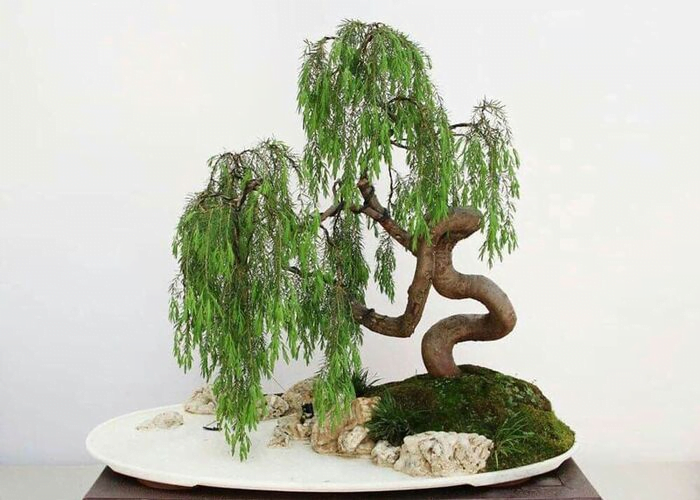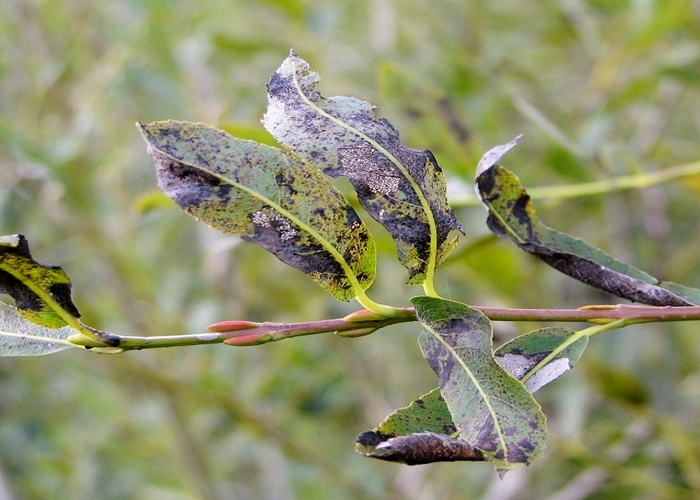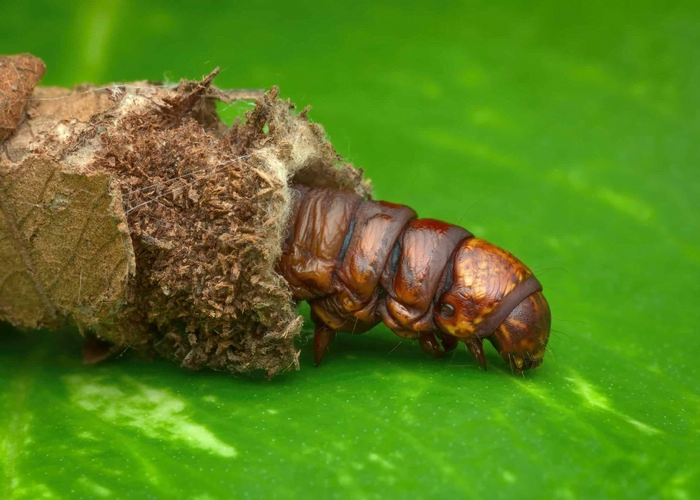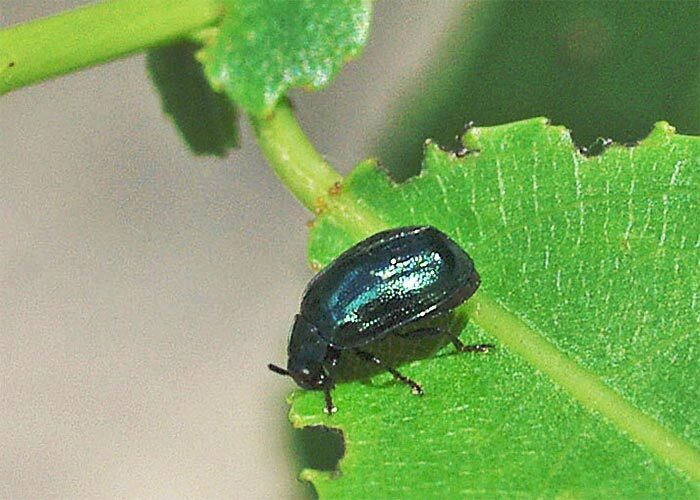Willow bonsai’s unique and enchanting qualities make it a favorite among bonsai enthusiasts. Even the busiest passerby can be stopped in their tracks by a weeping willow bonsai.
Also, there’s nothing more beautiful than drooping branches, drooping leaves, and drooping flowers on this bonsai tree. It looks dramatic in any kind of bonsai style, which makes it the favorite of most bonsai growers. Additionally, you’ll see results in just a few years as the weeping willow bonsai tree grows fast.
In this post, we’ll look at how to water, feed, prune, and maintain weeping willows in detail.

Weeping Willow Bonsai Quick Facts
| Fact | Description |
|---|---|
| Scientific Name | Salix babylonica |
| Family | Salicaceae family |
| Native to | China |
| Lifespan | 80 to 200 years |
| Height | 20 m (65ft) tall |
| Leaves | Lance-shaped, bright green, appears slightly twisted or curled and grows 3- to 6-inches long |
| Fall foliage | Yellow color |
| Fruit | 1/16″ (3mm) long, brown, conical capsules |
| Cultivation | Popular as a bonsai tree |
| Symbolism | It represents fertility and new life |
| Uses | Ornamental bonsai plants |
Weeping Willow Bonsai Care Guide
Taking care of a weeping willow bonsai means paying attention to its water, soil, temperature, and repotting needs. You’ll get a healthy willow bonsai if you take care of these things. So, let’s go over each of these areas in detail and provide tips for keeping your Weeping Willow Bonsai healthy.
Weeping Willow Bonsai Tree Watering
During the summer, willow bonsai need a lot of water and need to be watered frequently. Also, make sure your soil doesn’t dry out.
Moreover, in the first year after planting, weeping willows need weekly watering. Afterward, just water it enough to prevent it from drying out. You can check this by sticking your index finger into the soil around the area. It’s time to water if the top two inches feel dry.
To prevent drought damage, you can even put the pot in a shallow bowl of water. Furthermore, in winter, water less, but keep the rootball moist.
Learn more about Watering a bonsai tree.
Weeping Willow Bonsai Temperature Tolerance
Sunny spots are ideal for willows. They prefer sunny skies and temperatures between 80-90°F during the peak growing season.
However, on hot summer days, provide partial shade if the temperatures reach triple digits.
Right Placement for Weeping Willow Bonsai
While willows prefer sunny areas during the growing season, they may require semi-shade during the hottest months.
Moreover, in winter, if they are planted in containers, weeping willow bonsai will need protection.
For winter, you can put your willow bonsai tree in a cold but frost-free greenhouse, garage, or shed.
Repotting Weeping Willow Bonsai
Keeping Weeping Willow Bonsai healthy requires repotting, since it allows the tree to absorb the nutrients it needs. Also, as the roots of willows grow fast, they fill up the bonsai pot fast. Because of that, you have to re-pot willow bonsai every year as the buds grow. Before new growth starts in the spring, it’s best to repot your bonsai.
Here are the steps to repot weeping willow bonsai:
- Choose a larger pot with adequate drainage holes. Also, to keep soil from escaping, cover drainage holes with mesh or screen.
- Use a chopstick or root hook to gently loosen the soil around the bonsai.
- Cut off any dead, damaged, or long roots with sterile scissors. Don’t remove too much.
- Next, put fresh, well-draining soil in the new pot. Add more soil around the roots and gently press down to get rid of any air pockets.
- Then water the tree thoroughly, letting the excess water drain out.
- After repotting, put the Weeping Willow Bonsai in a shaded area for a few days to get used to its new home.
Repotting tips: For new root growth, prune the roots hard. Additionally, the soil should retain enough water but have good drainage at the same time.
As willow likes a slightly alkaline soil mix, so add some pumice or limestone gravel.
Best Soil for Weeping Willow Bonsai
For weeping willow bonsai, select soil that retains water but drains well. Hence, it’s best to choose sandy loam soil. Soil like this absorbs water and nutrients well and drains excess water and fertilizer. Additionally, this has good aeration properties that let oxygen pass through the soil.
Despite loving constant moisture, weeping willow bonsai suffer from waterlogging during the growing season.
For weeping willow bonsai tree, acidic soil is ideal. Also, many enthusiasts prefer red akademas with gravel and peat moss.
How to Guides for Weeping Willow Bonsai
Throughout this section, we’ll cover pruning, wiring, and fertilizing your Weeping Willow Bonsai, and when and how to do each.
How to Prune Weeping Willow Bonsai

Keeping a weeping willow bonsai healthy, maintaining its shape, and promoting new growth requires pruning. Additionally, when it’s dormant, which is usually late winter or early spring, is the best time to prune weeping willows. Here’s how you prune a weeping willow bonsai:
- Find branches that are too long, out of shape, or crossing each other. To maintain the bonsai’s shape and growth, prune these branches with sharp and clean pruning shears or scissors.
- Cut off any dead or diseased branches. As a next step, remove any branches growing towards the center of the tree. Also, don’t leave branches growing straight up or down, as they can also mess with the bonsai’s shape.
- Trim the branches back to a bud or lateral branch with pruning shears. However, keep your cut surface at an angle to prevent water pooling.
- If necessary, adjust your weeping willow bonsai after pruning to maintain its shape. If it has fallen leaves or debris, remove them and water bonsai tree.
How to Wire a Weeping Willow Bonsai
From June on, wire new shoots to hang down. Additionally, get the wire out of the bark before it bites into it. In spring, you can pull down older branches with guy wires.
- Make sure you choose the right wire thickness. And calculate how much wire you need.
- Wrap the wire around the branch. Make a 45-degree turn.
- Along the branch, wrap the wire neatly. After you’re done wiring, use pliers to cut the excess.
- Bend the branches gently. Take it slow so you don’t damage the plant.
- It’s easy to bring down high branches with a guy wire. Using raffia or protective material, wrap the branch and hook the end.
- Use a slender piece of wire to anchor the hook. It will bring down the high branch.
- Remove the wires in the same season. And observe how your Weeping Willow bonsai grows after wiring.
- Provide daily water and place it in a shady spot. Also, feed it with a balanced fertilizer.
Learn more about How to Wire a Bonsai Tree Branch
How to Fertilize Weeping Willow Bonsai Tree
You need to fertilize weeping willows often. When it’s warm, feed the bonsai tree every two weeks with a water-soluble fertilizer.
One time a month is sufficient in the winter. In the case of an indoor tree, once a month is enough.
However, check the nitrogen levels and make sure they’re high in phosphorus and potassium. If you use nitrogen fertilizers, you’ll get large leaves, long internodes, and bigger pest problems.
Check this detailed guide on How to Fertilize your Bonsai Trees the Correct Way
How to Grow a Weeping Willow Bonsai Tree
Growing weeping willow bonsais by seedling or cutting can be fun and rewarding. Although both methods have their advantages and disadvantages, they can both produce healthy and vibrant weeping willow bonsai trees. I’ll show you both methods below:
How to Grow Weeping Willow Bonsai from Seed
- Use a shallow pot that’s large enough to hold four seeds. Put some peat seed sowing mix.
- Sprinkle the Weeping Willow seeds on top. Keep a cover off the pot because germinating seeds need sunlight.
- Moisten the soil completely. Soaked soil should drip off the sides of the pot.
And put the seeds outside in the sun. - Always keep the soil moist. Keep your soil soaked when your seeds are germinating. It’ll take a few weeks for these seeds to germinate.
Check this detailed guide on How to grow a bonsai tree from seed?
How to Grow Weeping Willow Bonsai from Cutting
- Take cuttings from healthy Weeping Willows. Make sure it’s a healthy stem.
- Get a sharp knife or cutter and cut the tree cuttings. Cut the cutting diagonally from the tree.
- To avoid air pockets in the stems, place the cutting in water.
- Keep the cuttings in water until they root.
- You can now plant the cuttings in soil once the roots have thickened.
- Make sure you water the cuttings every day. If the weather’s warm, water the soil regularly.
Common Weeping Willow Bonsai Problems and Solutions / Diseases & Pests
1. Gypsy Moth

From late May to early July, you can find gypsy moth caterpillars eating willow trees. They can defoliate willow trees, making them weak and more susceptible to disease.
Solution: In most cases, Bacillus thuringiensis spray is used against gypsy moths. Within a week of application, this bacterial insecticide kills caterpillars.
2. Crown Gall

A crown gall is a bacterial infection that causes galls to form on willow roots and stems. Moreover, a lot of galls can cause stunting, discoloration, and dieback. In addition to making the tree more susceptible to secondary tree diseases, crown galls can cause it to rot.
Solution: You can prevent Crown gall infections by using Agrobacterium radiobacter K-84. Put water and Agrobacterium radiobacter K-84 in a bucket and drench bare root.
3. Willow Scab

Young willow branches and leaves are easily killed by this fungus. Symptoms of willow scab include olive green spore masses along veins. Also, it is often paired with black canker.
Solution: Several applications of mancozeb or dormant lime sulfur are required to control willow scab. In the fall, continue to treat the tree, and treat it again in the spring.
4. Black Canker

A black canker causes dark brown spots on the leaves. On stems and twigs, there is black-bordered gray-white lesions.
Solution: You can control black canker by applying chlorothalonil fungicide following the instructions on the label.
5. Bagworm

Willow tree leaves and twigs are the favorite food of bagworm caterpillars. A willow tree with bagworm infestation will have defoliation and 2-inch long bags of tough silk hanging from its branches like ornaments.
As a result of severe defoliation caused by bagworm infestations, a willow tree can grow slowly and be vulnerable to secondary pests.
Solution: The use of an insecticide that contains malathion, diazinon, or carbaryl (such as Ortho Tree & Shrub Insect Killer) will eradicate your bagworm problem when the larvae are still small.
6. Willow Leaf Beetle

Willow leaf beetles feed on willow trees’ leaves until they skeletonize them. A willow leaf beetle infestation causes defoliation, brown crumbling leaves, and metallic, greenish-blue oval beetles that feed in clusters.
Solution: Insecticides such as biphenthrin, chlorpyrifos, and pyrethrin are used to control willow leaf beetles.
Weeping Willow Bonsai Poisonous to Cats & Dogs
Almost every part of the willow bonsai plant is toxic to animals, from the seed to the leaves to the fruit. Contact your vet if you know your cat or dog ate the weeping tree, even if it’s only mild poisoning.
Weeping Willow Bonsai Tree Images



